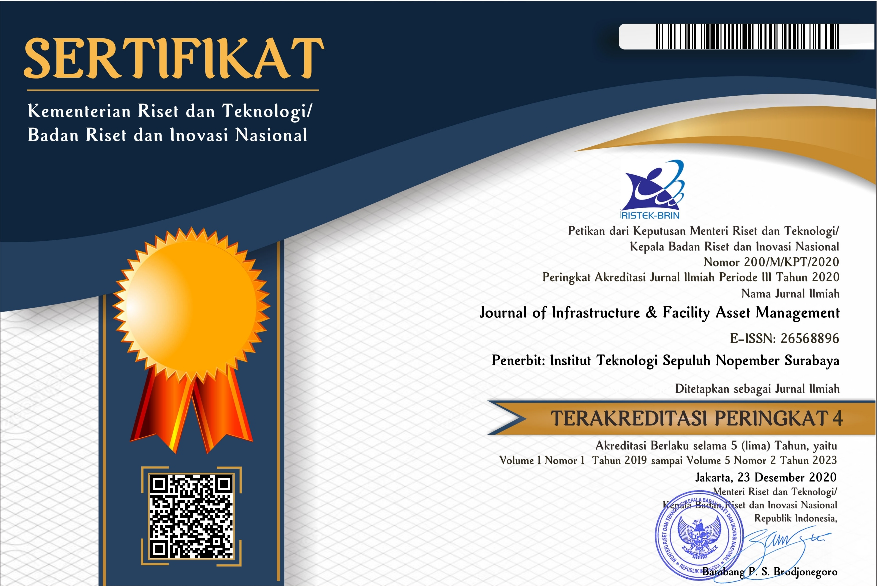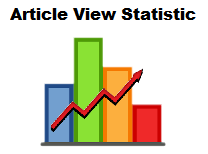Gradation Analysis of Reclaimed Asphalt Pavement from National Road as Asphalt Concrete Layer
Abstract
One of the assets of land transportation infrastructure that obtained attention now is the road. Road construction can support the developing economy, industry, trade, people and good mobility, regional development. Management of road infrastructure assets require to prioritize natural resources managements efficiently as possible. Reclaimed Asphalt Pavement (RAP) is the result of dredging material with aggregate gradation condition that are not in accordance with the needs of the gradation envelope. Utilization of RAP as a pavement layer is an effort to converse the use of natural materials. The efficiency aspect of RAP aggregate use needs to be done by determining the road pavement layer that is most appropriate to the condition of the RAP aggregate so that the addition of new aggregates is kept to a minimum. The aim of this study was to obtain a suitable pavement layer determination based on the aggregate gradation of RAP and standard specifications.
The method used literature study from previous research and RAP aggregate sieve analysis from national roads in East Java Province. The results showed that the utilization of RAP from national roads based on the RAP aggregate conformance value were AC-WC layer of 82.292%, AC-BC layer of 68.75% and AC-Base layer of 41.667%. Based on the gradation analysis, it is found that the RAP aggregate is best suited for the AC-WC layer, because it requires optimal RAP aggregate and the most efficient of additional aggregate.
Full Text:
PDFReferences
Bina Marga. (2018). Spesifikasi Umum Bina Marga Tahun 2018. Direktorat Jenderal Bina Marga Kementerian Pekerjaan Umum. Jakarta.
Budianto, H. (2009). Menuju Jalan yang Andal, PT. Cakra Daya Sakti. Surabaya.
Departemen Pemukiman dan Prasarana Wilayah. (2002). Manual Pekerjaan Campuran Beraspal Panas. Direktorat Jenderal Prasarana Wilayah. Jakarta.
Falevi, R. (2012). Optimalisasi Penggunaan Reclaimed Asphalt Pavement (RAP) sebagai Bahan Campuran Beraspal Panas (Asphaltic Concrete) Tipe AC-Wearing Course (AC-WC) Gradasi Halus dengan Menggunakan Aspal Pen 60-70 Variasi Abrasi Agregat Baru (Studi Kasus Jalan Nasional Pandaan – Malang). Tesis Pasca Sarjana. Institut Teknologi Sepuluh Nopember Surabaya.
Handayani, R. (2016). “Analisa Penggunaan Reclaimed Asphalt Pavement (RAP) sebagai Bahan Campuran Beraspal Panas Tipe Asphalt Concrete-Binder Course (ACBC) dengan Menggunakan Fly Ash (Studi Kasus Ruas Jalan Taman Waru)”. Tesis Pasca Sarjana. Institut Teknologi Sepuluh Nopember Surabaya.
Harahab, S. Soemitro, R.A.A, Budianto, H. (2013). “Optimalisasi Penggunaan Reclaimed Asphalt Pavement (RAP) sebagai Bahan Campuran Beraspal Panas (Asphaltic Concrete) Tipe AC-Wearing Course (AC-WC) Gradasi Kasar dengan Aspal Pen 60-70 dan Aspal Modifikasi Jenis TRS 55 (Studi Kasus Jalan Nasional Pandaan-Malang dan Jalan Nasional Pilang-Probolinggo)”. Prosiding Seminar Nasional Pascasarjana XIII – ITS, Surabaya 15 Agustus 2013, ISBN No. 978-979-96700-6-9.
Herawati, N., Soemitro, R.A.A., Budianto, H. (2012). “Analisis Penentuan Komposisi Optimal Penggunaan Reclaimed Asphalt Pavement (RAP) sebagai Bahan Campuran Beraspal Panas (Asphaltic Concrete) Menggunakan Aspal Modifikasi (Studi Kasus Jalan Pilang – Probolinggo)”. [7] Prosiding Seminar Nasional Aplikasi Teknologi Prasarana Wilayah (ATPW) Surabaya, 11 Juli 2012. ISSN 2301-6752, Material Bahan Bangunan dan Konstruksi, hal. F-1.
Kusmarini, E.P., Soemitro, R.A.A., Budianto, H. (2012). “Analisis Penggunaan Reclaimed Asphalt Pavement (RAP) dan Aspal Pen 60 – 70 sebagai Bahan Campuran Beraspal Panas (Asphaltic Concrete) (Studi Kasus Ruas Jalan Gemekan – Jombang dan Pandaan – Malang)”. Prosiding Seminar Nasional Aplikasi Teknologi Prasarana Wilayah (ATPW) Surabaya, 11 Juli 2012, ISSN 2301-6752, Material Bahan Bangunan dan Konstruksi, hal. F-5 – F-10.
National Asphalt Pavement Association - NAPA (1996). Hot Mix Asphalt Materials Mixture Design and Construction. NAPA Education Foundation. Maryland.
Ortiz, O. R. Berardinelli, A., Carvajal-M., Fuentes, L.G. (2012). “Evaluation of Hot Mix Asphalt Mixtures with Replacement of Aggregates by Reclaimed Asphalt Pavement (RAP) Material”, Procedia Sosial and Behavioral Sciences 53, hal. 379-388.
Parveez, Prateek, Srikanta, Yathiraj, Konnur, Dinesh, (2013). “Study on the Effect of Reclaimed Asphalt Pavement (RAP) on the Mechanical Behaviour of Hot Mix Asphalt”, India.
Pradyumna, T Anil. Mittal, Abhishek, Jain, P.K. (2013). “Characterization of Reclaimed Asphalt Pavement (RAP) for Use in Bituminous Road Construction”, Procedia-Social and Behavioral Sciences 104, hal. 1149-1157.
Shen, J., Amirkhanian, S., Aune, J.M. (2007). “Effects of Rejuvenatin Agents of Superpave Mixtures Containing Reclaimed Asphalt Pavement”. Journal of Materials in Civil Engineering. ASCE. May. 2007.
Sujiartono, A. (2014). Optimalisasi Penggunaan Reclaimed Asphalt Pavement (RAP) sebagai sebagai Bahan Campuran Beraspal Panas (Asphaltic Concrete) Tipe AC-Binder Course (AC-BC) dan AC-Base Course (AC-Base) dengan Menggunakan Aspal Modifikasi Asbuton (BNA-Blend) (Studi Kasus Jalan Nasional Pilang-Probolinggo). Tesis Pasca Sarjana. Institut Teknologi Sepuluh Nopember Surabaya.
Sukirman, S. (1995). Perkerasan Lentur Jalan Raya, Penerbit Nova. Bandung.
Sukirman, S. (2003). Beton Aspal Campuran Panas, Penerbit Granit. Jakarta.
Suwantoro (2010). Optimalisasi Penggunaan Material Hasil Cold Milling untuk Daur Ulang Lapisan Perkerasan Beton Aspal Tipe AC (Asphaltic Concrete). Tesis Pasca Sarjana. Institut Teknologi Sepuluh Nopember Surabaya.
TRB (2011). A Manual for Design of Hot Mix Asphalt with Commentary. National Cooperative Highway Research Program. NCHRP Report 673. Transportation Research Board. Washington DC.
Wibowo, H.W. (2012). Optimalisasi Penggunaan Reclaimed Asphalt Pavement (RAP) sebagai Material Campuran pada Asphaltic Concrete Tipe AC–BC dan AC–Base dengan Pen 60-70 (Studi Kasus Jalan Nasional Pandaan – Malang). Tesis Pasca Sarjana. Institut Teknologi Sepuluh Nopember Surabaya.
Widayanti, A., Soemitro, R.A.A., Ekaputri, J. E. & Suprayitno, H. (2017). “Characteristics of Reclaimed Asphalt Material from National Road in East Java Province”. Jurnal Manajemen Aset Infrastruktur & Fasilitas, Vol. 1, No. 1, Desember 2017.
Widayanti, A., Soemitro, R.A.A., Ekaputri, J. E. & Suprayitno, H. (2018). “Performances of Asphalt Concrete Contain Reclaimed Asphalt Pavement from National Road in East Java Province”. Jurnal Manajemen Aset Infrastruktur & Fasilitas, Vol. 2, No. 1, Maret 2018.
Widayanti, A., Soemitro, R.A.A., Ekaputri, J. E. & Suprayitno, H. (2012). “Economic Aspect of Reclaimed Asphalt Pavement Utilization from National Road in East Java Province”. Jurnal Manajemen Aset Infrastruktur & Fasilitas, Vol. 2, Suplemen 2, Desember 2018.
Widger, A., Skilnick, F., Zabolotnii, E. (2012). Utilization of Recycled Asphalt in Cold Mixes and Cold In-Place Recycling Processes-Guidelines. Engineer-In-Training Clifton Associated Ltd. Communities of Tomorrow, Leveraged Municipal Innovation Fund.
Xiao, F., Amirkhanian, S.N., Shen, J., Putman, B. (2009). “Influences of Crumb Rubber Size and Type on Reclaimed Asphalt Pavement (RAP) Mixtures”, Construction and Building Materials 23, pp.1028-1034.
Xiao, F., Amirkhanian, Serji, J., Hsein, C. (2007). “Rutting Resistance of Rubberized Asphalt Concrete Pavements Containing Reclaimed Asphalt Pavement Mixtures”, Journal of Materials in Civil Engineering, ASCE, June 2007, pp. 475-483.
DOI: http://dx.doi.org/10.12962/jifam.v1i1.5205
Refbacks
- There are currently no refbacks.
Visitor :
Flag Counter

Journal Of Infrastructure & Facility Asset Management by Institut Teknologi Sepuluh Nopember is licensed under a Creative Commons Attribution-ShareAlike 4.0 International License.





